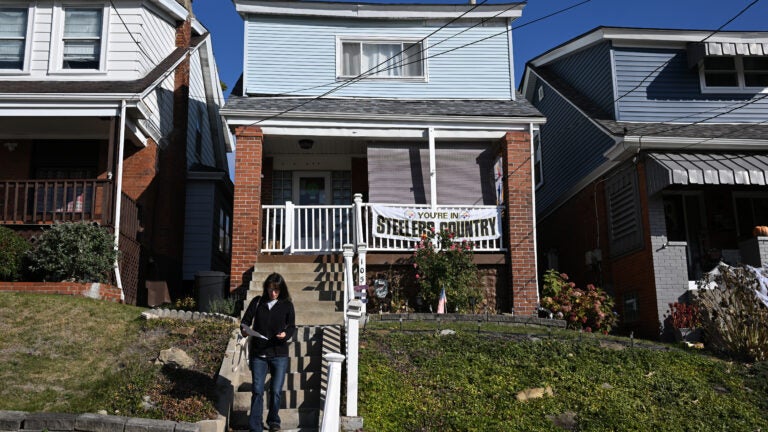Real Estate
While there are many yardsticks for calculating housing affordability, Pittsburgh stands out as uniquely livable.

PITTSBURGH – As real estate prices and interest rates shot up in recent years,the prospect of homeownership moved further for many Americans, especially young adults in large metro areas where themedian home price can run well over half-a-million dollars.
But not in Pittsburgh, where Isaac Ray, 26, and Liam Weaver, 30, bought their first home for $163,000. After dropping $10,000 to rehab the bathroom and decrepit kitchen cabinets, they settled into their three-bedroom, one-bath ranch in the West End before their October wedding.
“A lot of people think about buying a house, and it just seems it’s something you probably can’t do,” Weaver said of the cost. But it’s well within reach here on what he earns managing a grocery store deli counter and Ray as a professional ballet dancer. And it’s a far cry from markets like Seattle, where Weaver said his stepbrother had been looking at properties much like his own, except at five times the asking price.
Though the housing market has tempered since the frenetic days of 2020, prices remain relentlessly high; the U.S. median topped $410,800 in the second quarter, a more than 50 percent climb in five years, according to Federal Reserve data. For people on the coasts, median valuations are more imposing in such markets as Seattle ($762,000), Boston ($812,000) and Los Angeles ($995,000).
It’s $229,000 in the greater Pittsburgh area.
How the city has remained one of the nation’s most affordable is a story with many threads, chief among them the law of supply and demand. Since the steel industry that defined it collapsedfivedecades ago, Pittsburgh simply has more houses than people looking to buy them, including 25,000 properties that are vacant or abandoned. Plus inventory skews toward aging homes in need of upgrades, further leveling prices.
Wages are robust relative to home prices, a reflection of a diversified economy fueled by higher education, health care, financial services, tourism and technology, which have propelled the local median to $77,050. This year alone, Mitsubishi, Nippon Steel, Hitachi Energy and other companies expanded their footprint in Pittsburgh.
Meanwhile, city, regional and state leaders are investing in public programs and private redevelopment to further housing affordabilityand guard against what happened in Austin and Miami; prices soared, in part, because of an influx of residents drawn by their reputations for affordability.
The conditions have implications for residents and newcomers alike, given the role of homeownership as a key stepping stone for financial stability and generational wealth.
After years of declining population, the city added 4,708 residents from 2020 to 2024, according to U.S. Census Bureau estimates, outpacing most Pennsylvania jurisdictions. More than 60 percent of that increase occurred between 2023 and 2024.
Real estate agent Brian Larson said remote workers are discovering Pittsburgh. “They’re realizing I can work from home and have twice the home,” he said.
America’s most affordable
The cost of living is a top concern for many Americans, and a defining issue of the 2024 election that helped return Donald Trump to the White House. Trump places much of the blame for high housing costs on Federal Reserve Chair Jerome H. Powell and has been agitating for the Fed to more aggressively cut the interest rates that underpin mortgages. But there are other affordability hurdles, including wage growth that can’t keep up with housing costs and a dearth of starter homes – smaller, often less pristine properties that owners typically trade up for after three to five years.
While economists have many yardsticks for calculating housing affordability, Pittsburgh stands out as uniquely livable.
It’s cheaper to own a home than rent one in Pittsburgh. The real estate site Zillow identified it as one of three cities with the most favorable gap between mortgagepayments and rent. As a result, more than 70 percent of Pittsburghers are homeowners, outpacing the national rate by about five percentage points.
Nor do current interest rates, which have hovered above 6 percent on a 30-year mortgage since September 2022,undermine that. By a Zillow metric, Pittsburgh would be considered affordable even at a 9 percent mortgage for someone earning the local median income. By comparison, borrowers in Milwaukee and Salt Lake City would need rates to drop to 4 and 3 percent, respectively.
A similar analysis found that at today’s mortgage rates, Pittsburgh is the nation’s most affordable city, followed by Detroit and St. Louis, in allowing households to realistically spend no more than 30 percent of their paycheck on their mortgage. That’s impossible for the average household almost anywhere else in the country.
Fixer-uppers everywhere
People here don’t always think they’re living in a mecca of affordability. In fact, people in Pittsburgh sound a lot like people everywhere – concerned about how expensive houses are nowadays.
“We have this scenario where still, many low-income renters and working families are still priced out, because of the wages in Pittsburgh,” city council member Bobby Wilson said. “I just don’t think people are making that much here, to think about housing as” affordable.
Like any other city, a median-priced home varies widely by neighborhood and condition. Here, it can be a three-bed, two-bath house with its own courtyard near the bustling bars and restaurants of East Carson Street. Or a two-bedroom, one-level home in the Westwood area that has been in the same family since 1959.
Luke Revitsky, 34, wanted to buy in the Dormont area, where he and his fiancé have been renters. After months looking for a house in suitable condition, he ended up paying $215,000 for a house he knew would need at least $30,000 of work. “It needed a new roof. It needed new electric. … It hasn’t really been updated since the ’60s or ’70s,” he said. The sale closed last week, and the couple expects to move in soon. “There are a lot of houses that are outdated in Pittsburgh. It’s either super competitive, or it needs a lot of work.”
Sergio and Franchesca Pizzurro walked through a $235,000 one-bedroom condominium in a sleek new building not far from the hot Lawrenceville neighborhood. Buyers started moving in two years ago, and today, 12 of the 19 units have been sold. The city has waived property taxes for buyers for 10 years – one of Pittsburgh’s many efforts to juice home construction.
The couple, an exterminator and a math teacher, bought their first home seven years ago in nearby Morgantown, West Virginia, for $275,000 when he was 25 and she was 22. They often spend weekends in Pittsburgh with their 4-year-old, and they are looking for a second home that they can sometimes use when they take in a Steelers game or a museum and sometimes rent out as an Airbnb.
“We’re aware how fortunate we are to even be considering such a thing,” Franchesca said. She dreams sometimes of living in a bigger city. But prices here allow them to be homeowners. That, she wouldn’t trade.
Public programs
A little more than a century ago, Pittsburgh was one of the most affluent cities in the country, home to magnates Andrew Mellon and Andrew Carnegie. The steel industry transformed the city, bringing civic institutions such as Carnegie Mellon University and a hilltop observatory as the economy flourished. At its peak in 1950, the population exceeded 675,000.
Then foreign competition battered the industry in the 1970s and ’80s, and the steel mills left the city, leading to massive job losses and an exodus of residents.Today, about 308,000 people call the city home.
Its largest employers include universities (University of Pittsburgh, Carnegie Mellon, Duquesne), hospitals and the government. Pittsburgh has struggled to attract new employers – the metro area’s failure to regain jobs lost since the beginning of the covid pandemic ranks second-worst in the nation, according to the Federal Reserve – but has seen some success drawing AI companies and advanced manufacturing.
“We have a long history of making things,” said Stefani Pashman, who works to attract companies to the county as CEO of the Allegheny Conference on Community Development. The city’s affordability attracts newcomers, a trend that community leaders regard with both excitement and apprehension. “The thing we talk a lot about here is how we can get more growth, and within that, how we can maintain this affordability.”
They are trying multiple approaches. Legislation passed this year reduces minimum lot sizes to encourage construction of more dense housing. A land bank acquires properties in blighted neighborhoods, where nonprofits can then build affordable housing. A program offers first-time buyers earning up to 80 percent of the median income up to $90,000 toward their home purchases. The Urban Redevelopment Authority gives developers zero-interest loans to turn vacant downtown office buildings into housing and pays developers to set aside apartments in their buildings as designated affordable units. (A bitter year-long fight is also underway about a program that would require the inclusion of designated affordable units by law.)
“We’re that last money that the developer needs,” said Quianna Wasler, who runs the Urban Redevelopment Authority. Inflation, tariffs, supply chain disruptions and other shocks have made it more expensive to help finance those affordable units. “We’ve been able to adjust,” she said. “But [whether we] can maintain at these levels is the question.”



